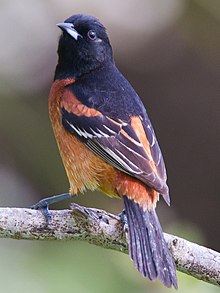Orchard oriole
| Orchard oriole | |
|---|---|
 |
|
| Adult male I. s. spurius | |
| Scientific classification | |
| Kingdom: | Animalia |
| Phylum: | Chordata |
| Class: | Aves |
| Order: | Passeriformes |
| Family: | Icteridae |
| Genus: | Icterus |
| Species: | I. spurius |
| Binomial name | |
|
Icterus spurius (Linnaeus, 1766) |
|
 |
|
| Range of I. spurius Breeding range Wintering range | |
The orchard oriole (Icterus spurius) is the smallest species of icterid. The subspecies of the Caribbean coast of Mexico, I. s. fuertesi, is sometimes considered a separate species, the ochre oriole or Fuertes's oriole.
This species is 6.3 in (16 cm) long and weighs 20 g (0.71 oz). The bill is pointed and black with some blue-gray at the base of the lower mandible (Howell and Webb 1995). The adult male of the nominate subspecies has chestnut on the underparts, shoulder, and rump, with the rest of the plumage black. In the subspecies I. s. fuertesi, the chestnut is replaced with ochre (Howell and Webb 1995). The adult female and the juvenile of both subspecies have olive-green on the upper parts and yellowish on the breast and belly. All adults have pointed bills and white wing bars. (Orchard orioles are considered to be adults after their second year.) One-year-old males are yellow-greenish with a black bib.
The breeding habitat is semi-open areas with deciduous trees. I. s. spurius breeds in spring across eastern North America from near the Canada–United States border south to central Mexico. A 2009 study also found breeding in the thorn forest of Baja California Sur and the coast of Sinaloa during the summer "monsoon"; this region had previously been thought to be only a migratory stopover (Rohwer, Hobson, and Rohwer, 2009). I. s. fuertesi breeds from southern Tamaulipas to Veracruz (Howell and Webb 1995). These birds enjoy living in shaded trees within parks along lakes and streams. The nest is a tightly woven pouch attached to a fork on a horizontal branch. Their nests tend to sit close together.
The nominate subspecies' winter range extends from the coastal lowlands of central Sinaloa and southern Veracruz south to northern Colombia and northwestern Venezuela (Scharf and Kren 1996). The ochre subspecies has been observed in winter on the Pacific slope of Mexico (Howell and Webb 1995).
...
Wikipedia

